Red eggs for Easter, yellow ones too
Duration/age

Spotty eggs, stripy eggs, coloured eggs, so many eggs!
You can decorate eggs with your child at any time of the year and many families like to do this at Easter. Your eggs can be as simple or as complicated as you like. It is best to use hard-boiled eggs for decorating. There are many ways you and your child can decorate the eggs.
Simply draw on the eggs with wax crayons or textas. If you use warm eggs the crayons will melt onto the eggs.
What will you draw on this egg? Which part of the egg is the top?
There are several ways to use food colouring to colour eggs.
Add some food colouring to cold water in a cup and let the egg soak until it is coloured. Use a spoon to lower the egg in. Use different cups for the different colours.
Can you carefully lower the egg on the spoon into the water? How long do you think it will take? Is it coloured enough yet?
To make stripy eggs, start with about a centimetre of strong food colouring in the cup and put the egg into it. When the egg has started to take the dye, add another centimetre of water, then another and another. Keep going until your egg is looking good.
This egg is dark green and light green and pale green and white.
Your child could also use the crayon to draw on the egg before you dye it.
As well, you could put some stickers on the egg before dyeing it - stars and spots work well.
Materials you will need
- Crayons
- Spoon
- Stickers
- Textas
- Water
- Cups
- Hard-boiled eggs
- Food colouring
Skills this activity improves
Why does this matter?
When your child is being creative they are expressing their ideas and knowledge.
As you dye the eggs with your child they will be learning to follow directions and interpret what you mean.
Creating and talking about the patterns that they are making helps your child to recognise and describe patterns around them.
What does this lead to?
Creative children can express their ideas in many different ways.
Following directions helps children to build logical thinking.
Recognising and making patterns is an important mathematical skill. Patterns help children to predict, sort and categorise.
Language to use
- Egg, hard-boiled
- Coloured, dye
- Spots, stripe
- Red, green, blue, yellow
- Dark, light, pale
- In, out
- Crayon, texta, draw
- Warm, melt
Questions to use
- How should we decorate this egg?
- Which colour should we try first?
- Do you think it's been in there long enough? Let’s see.
Useful tips
- Add some vinegar to your dye. It helps the dye to set.
- Rub a little vegetable oil on the egg once they are decorated and dry. This makes them shiny and protects them.
- You might also like to take a look at the Treasure hunt activity.
- Remember to talk to your child in your home language.
More ideas
Mix the food colouring to make other colours. Red and blue make purple, blue and yellow make green.
Variation by age
Three to five year olds
- Hide the eggs in the garden or around the house and let your child hunt for them. Maybe they could hide them for someone else.
- Hold an egg and spoon race - how far can you carry a hard-boiled egg on a spoon?
Questions to ask
- Where could the eggs be? Are they under something? Are they behind something?
- Do you need to walk slowly or can you go fast?
Language to use
- Hide, seek, find, discover
- Under, next to, behind
- Far, near
- Close, nearly there
- Balance, wobble


